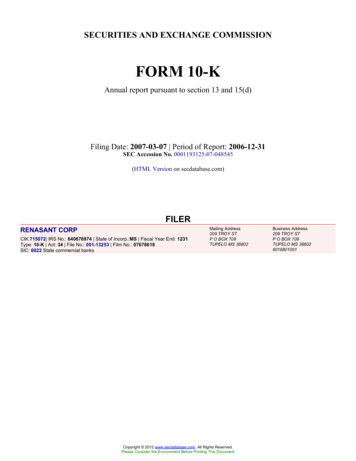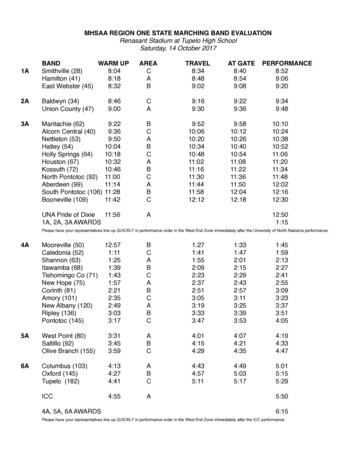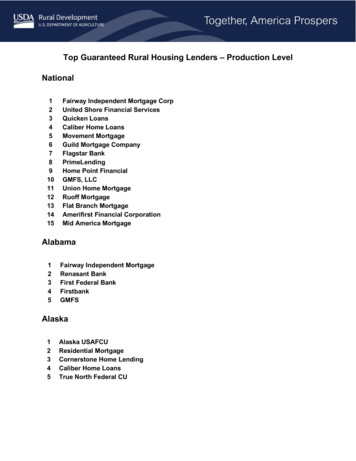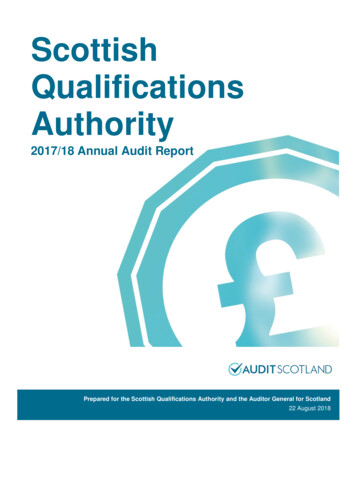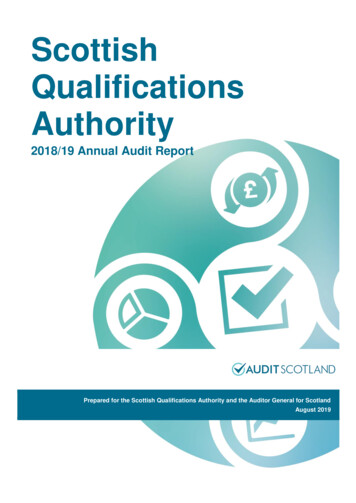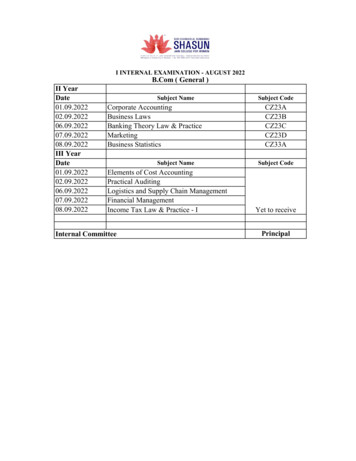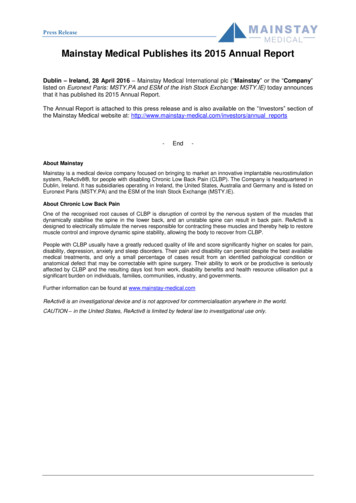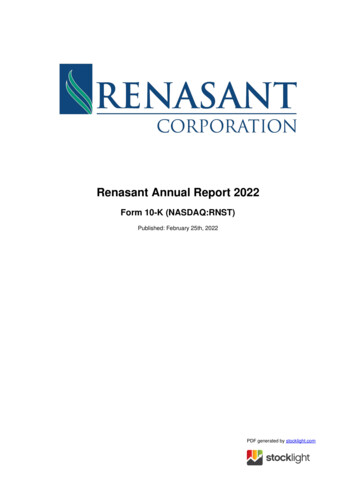
Transcription
Renasant Annual Report 2022Form 10-K (NASDAQ:RNST)Published: February 25th, 2022PDF generated by stocklight.com
UNITED STATESSECURITIES AND EXCHANGE COMMISSIONWashington, D.C. 20549FORM 10-K ANNUAL REPORT PURSUANT TO SECTION 13 OR 15(d) OF THE SECURITIES EXCHANGE ACT OF 1934For the fiscal year ended December 31, 2021or TRANSITION REPORT PURSUANT TO SECTION 13 OR 15(d) OF THE SECURITIES EXCHANGE ACT OF 1934For the transition period from toCommission file number 001-13253RENASANT CORPORATION(Exact name of registrant as specified in its charter)Mississippi(State or other jurisdiction ofincorporation or organization)64-0676974(I.R.S. EmployerIdentification No.)209 Troy Street,Tupelo,Mississippi(Address of principal executive offices)38804-4827(Zip Code)(662) 680-1001(Registrant’s telephone number, including area code)Securities registered pursuant to Section 12(b) of the Act:Title of each classCommon stock, 5.00 par value per shareTrading Symbol(s)RNSTName of each exchange on which registeredThe NASDAQ Stock Market LLCSecurities registered pursuant to Section 12(g) of the Act: NoneIndicate by check mark if the registrant is a well-known seasoned issuer, as defined in Rule 405 of the Securities Act.Indicate by check mark if the registrant is not required to file reports pursuant to Section 13 or Section 15(d) of the Act.Yes þ No Yes No þIndicate by check mark whether the registrant (1) has filed all reports required to be filed by Section 13 or 15(d) of the Securities Exchange Act of 1934 during thepreceding 12 months (or for such shorter period that the registrant was required to file such reports), and (2) has been subject to such filing requirements for the past90 days. Yes No Indicate by check mark whether the registrant has submitted electronically every Interactive Data File required to be submitted pursuant to Rule 405 of Regulation S-Tduring the preceding 12 months (or for such shorter period that the registrant was required to submit such files). Yes No Indicate by check mark whether the registrant is a large accelerated filer, an accelerated filer, a non-accelerated filer, a smaller reporting company, or an emerginggrowth company. See the definitions of “large accelerated filer,” “accelerated filer,” “smaller reporting company,” and “emerging growth company” in Rule 12b-2 of theExchange Act.Large Accelerated Filer Accelerated filer Non-accelerated filer Smaller reporting company Emerging growth company If an emerging growth company, indicate by check mark if the registrant has elected not to use the extended transition period for complying with any new or revisedfinancial accounting standards provided pursuant to Section 13(a) of the Exchange Act. Indicate by check mark whether the registrant has filed a report on and attestation to its management's assessment of the effectiveness of its internal control overfinancial reporting under Section 404(b) of the Sarbanes-Oxley Act (15 U.S.C. 7262(b)) by the registered public accounting firm that prepared or issued its auditreport. Indicate by check mark whether the registrant is a shell company (as defined in Rule 12b-2 of the Exchange Act). Yes No As of June 30, 2021, the aggregate market value of the registrant’s common stock, 5.00 par value per share, held by non-affiliates of the registrant, computed byreference to the last sale price as reported on The NASDAQ Global Select Market for such date, was 2,196,590,080.As of February 18, 2022, 55,815,152 shares of the registrant’s common stock, 5.00 par value per share, were outstanding.
DOCUMENTS INCORPORATED BY REFERENCEPortions of the Proxy Statement for the 2022 Annual Meeting of Shareholders of Renasant Corporation are incorporated by reference into Part III of this Form 10-K.
Renasant Corporation and SubsidiariesForm 10-KFor the Year Ended December 31, 2021CONTENTSPART IItem 1.Item 1A.Item 1B.Item 2.Item 3.Item 4.BusinessRisk FactorsUnresolved Staff CommentsPropertiesLegal ProceedingsMine Safety DisclosuresPage21525262626PART IIItem 5.Item 6.Item 7.Item 7A.Item 8.Item 9.Item 9A.Item 9B.Item 9C.Market for Registrant’s Common Equity, Related Stockholder Matters and Issuer Purchases of Equity Securities[Reserved]Management’s Discussion and Analysis of Financial Condition and Results of OperationsQuantitative and Qualitative Disclosures About Market RiskFinancial Statements and Supplementary DataChanges in and Disagreements with Accountants on Accounting and Financial DisclosureControls and ProceduresOther InformationDisclosure Regarding Foreign Jurisdictions that Prevent Inspections2728296162145146146147PART IIIItem 10.Item 11.Item 12.Item 13.Item 14.Directors, Executive Officers and Corporate GovernanceExecutive CompensationSecurity Ownership of Certain Beneficial Owners and Management and Related Stockholder MattersCertain Relationships and Related Transactions, and Director IndependencePrincipal Accountant Fees and Services148148148149149PART IVItem 15.Item 16.Exhibits and Financial Statement SchedulesForm 10-K Summary150154
CAUTIONARY NOTE REGARDING FORWARD-LOOKING STATEMENTSThis Annual Report on Form 10-K may contain or incorporate by reference statements regarding Renasant Corporation (referred to herein as the“Company”, “we”, “our”, or “us”) that constitute “forward-looking statements” within the meaning of Section 27A of the Securities Act of 1933, as amended,and Section 21E of the Securities Exchange Act of 1934, as amended. Statements preceded by, followed by or that otherwise include the words“believes,” “expects,” “projects,” “anticipates,” “intends,” “estimates,” “plans,” “potential,” “focus,” “possible,” “may increase,” “may fluctuate,” “will likelyresult,” and similar expressions, or future or conditional verbs such as “will,” “should,” “would” and “could,” are generally forward-looking in nature and nothistorical facts. Forward-looking statements include information about the Company’s future financial performance, business strategy, projected plansand objectives and are based on the current beliefs and expectations of management. The Company’s management believes these forward-lookingstatements are reasonable, but they are all inherently subject to significant business, economic and competitive risks and uncertainties, many of whichare beyond the Company’s control. In addition, these forward-looking statements are subject to assumptions with respect to future business strategiesand decisions that are subject to change. Actual results may differ from those indicated or implied in the forward-looking statements, and suchdifferences may be material.Important factors currently known to management that could cause our actual results to differ materially from those in forward-looking statements includethe following: the continued impact of the COVID-19 pandemic (and variants thereof) and related governmental response measures on the U.S. economy andthe economies of the markets in which the Company operates; the Company’s ability to efficiently integrate acquisitions into its operations, retain the customers of these businesses, grow the acquiredoperations and realize the cost savings expected from an acquisition to the extent and in the timeframe anticipated by management; the effect of economic conditions and interest rates on a national, regional or international basis; timing and success of the implementation of changes in operations to achieve enhanced earnings or effect cost savings; competitive pressures in the consumer finance, commercial finance, insurance, financial services, asset management, retail banking, mortgagelending and auto lending industries; the financial resources of, and products available from, competitors; changes in laws and regulations as well as changes in accounting standards; changes in policy by regulatory agencies; changes in the securities and foreign exchange markets; the Company’s potential growth, including its entrance or expansion into new markets, and the need for sufficient capital to support that growth; changes in the quality or composition of the Company’s loan or investment portfolios, including adverse developments in borrower industries orin the repayment ability of individual borrowers; an insufficient allowance for credit losses as a result of inaccurate assumptions; general economic, market or business conditions, including the impact of inflation; changes in demand for loan products and financial services; concentration of credit exposure; changes or the lack of changes in interest rates, yield curves and interest rate spread relationships; increased cybersecurity risk, including potential network breaches, business disruptions or financial losses; civil unrest, natural disasters, epidemics and other catastrophic events in the Company’s geographic area; the impact, extent and timing of technological changes; and
other circumstances, many of which are beyond management’s control.The Company believes that the assumptions underlying its forward-looking statements are reasonable, but any of the assumptions could prove to beinaccurate. Investors are urged to carefully consider the risks described elsewhere in this report and in the Company’s other filings with the Securitiesand Exchange Commission (the “SEC”) from time to time, including its Quarterly Reports on Form 10-Q, which are available at www.renasant.com andthe SEC’s website at www.sec.gov.The Company undertakes no obligation, and specifically disclaims any obligation, to update or revise forward-looking statements, whether as a result ofnew information or to reflect changed assumptions, the occurrence of unanticipated events or changes to future operating results over time, except asrequired by federal securities laws.The information set forth in this Annual Report on Form 10-K is as of February 18, 2022 unless otherwise indicated herein.PART IITEM 1. BUSINESSGeneralRenasant Corporation, a Mississippi corporation incorporated in 1982, owns and operates Renasant Bank, a Mississippi banking corporation withoperations in Alabama, Florida, Georgia, Mississippi, North Carolina, South Carolina and Tennessee. Renasant Bank, in turn, owns and operatesRenasant Insurance, Inc., a Mississippi corporation with operations in Mississippi, and Park Place Capital Corporation, a Tennessee corporation withoperations across our footprint. Renasant Bank is sometimes referred to herein as the “Bank,” while Renasant Insurance, Inc. is referred to herein as“Renasant Insurance” and Park Place Capital Corporation is referred to as “Park Place Capital.”Our vision is to be the financial services advisor and provider of choice in each community we serve. With this vision in mind, management has organizedthe branch banks into community banks using a franchise concept. The franchise approach empowers community bank presidents to execute their ownbusiness plans in order to achieve our vision. Specific performance measurement tools are available to assist these presidents in determining thesuccess of their plan implementation. A few of the ratios used in measuring the success of their business plan include:————return on average assetsthe efficiency ratioloan and deposit growthnet charge-offs to average loans————net interest margin and spreadfee income shown as a percentage of loans and depositsthe volume and pricing of depositsthe percentage of loans past due and nonaccruingWhile we have preserved decision-making at a local level, we have centralized our legal, accounting, investment, risk management, loan review, humanresources, audit and data processing/operations functions. The centralization of these functions enables us to maintain consistent quality and achievecertain economies of scale.Our vision is further validated through our core values. Our core values include: (1) employees are our greatest assets, (2) quality is not negotiable and(3) clients’ trust is foremost. Centered on these values was the development of our strategic plan, which focuses on attracting high quality, organic loangrowth and increasing our noninterest income, improving our operating efficiency and enhancing our technological capabilities, remaining opportunistic,and achieving financial performance targets. We believe that the successful implementation of our strategic plan will promote the satisfaction anddevelopment of our employees, clients and shareholders.Members of our Board of Directors also serve as members of the Board of Directors of the Bank (which has a broader membership than the Companyboard). Responsibility for the management of the Bank remains with the Board of Directors and officers of the Bank; however, management servicesrendered by the Company to the Bank are intended to supplement internal management and expand the scope of banking services normally offered bythe Bank.OperationsThe Company has three reportable segments: a Community Banks segment, an Insurance segment and a Wealth Management segment. We do nothave any foreign operations.
Operations of Community BanksSubstantially all of our business activities are conducted through, and substantially all of our assets and revenues are derived from, the operations of ourcommunity banks, which offer a complete range of banking and financial services to individuals and to businesses of all sizes. As described in moredetail below, these services include business and personal loans, interim construction loans, specialty commercial lending, treasury managementservices and checking and savings accounts, as well as safe deposit boxes and night depository facilities. Automated teller machines are locatedthroughout our market area, and we have interactive teller machines in many of our urban markets. Our Online and Mobile Banking products and our callcenter also provide 24-hour banking services.As of December 31, 2021, we had 189 banking, lending and mortgage offices located throughout our markets in Alabama, Florida, Georgia, Mississippi,North Carolina, South Carolina and Tennessee. Customers may also conduct many banking transactions, such as opening deposit accounts andapplying for certain types of loans, through our Online and Mobile Banking Products.Lending Activities. Income generated by our lending activities (including our Mortgage division), in the form of interest income, loan-related fees, andincome from the sale and servicing of mortgage loans, comprises a substantial portion of our revenue, accounting for approximately 78.66%, 84.01% and79.32% of our total gross revenues in 2021, 2020 and 2019, respectively. Total gross revenues consist of interest income on a fully taxable equivalentbasis and noninterest income. Our lending philosophy is to minimize credit losses by following strict credit approval standards, diversifying our loanportfolio by both type and geography and conducting ongoing review and management of the loan portfolio. Loans are originated through either ourcommercial lending groups or personal bankers depending on the relationship and type of service or product desired. Our commercial lending groupprovides banking services to corporations or other business customers and originates loans for general corporate purposes, such as financing forcommercial and industrial projects or income producing commercial real estate. Also included in our commercial lending group are experienced lenderswithin our specialty lines of business, which consist of our asset-based lending, Small Business Administration lending, healthcare, factoring, andequipment lease financing banking groups. Our personal banking group provides small consumer installment loans, residential real estate loans, lines ofcredit and construction financing and originates conventional first and second mortgages.The following is a description of each of the principal types of loans in our loan portfolio, the relative credit risk of each type of loan and the steps we taketo reduce such risk. Our loans are primarily generated within the market areas where our offices are located.— Commercial, Financial and Agricultural Loans . Commercial, financial and agricultural loans (referred to as “C&I loans”), which accounted forapproximately 14.20% of our total loans at December 31, 2021, are customarily granted to established local business customers in our market area on afully collateralized basis to meet their credit needs. The terms and loan structure are dependent on the collateral and strength of the borrower. Loan-tovalue ratios range from 50% to 85%, depending on the type of collateral. Terms are typically short term in nature and are commensurate with thesecondary source of repayment that serves as our collateral.Although C&I loans may be collateralized by equipment or other business assets, the repayment of this type of loan depends primarily on thecreditworthiness and projected cash flow of the borrower (and any guarantors). Thus, the chief considerations when assessing the risk of a C&I loan arethe local business borrower’s ability to sell its products/services, thereby generating sufficient operating revenue to repay us under the agreed upon termsand conditions, and the general business conditions of the local economy or other market that the business serves. The liquidation of collateral isconsidered a secondary source of repayment. Another source of repayment are guarantors of the loan, if any. To manage these risks, the Bank’s policyis to secure its C&I loans with both the assets of the borrowing business and any other collateral and guarantees that may be available. In addition, weactively monitor certain financial measures of the borrower, including advance rate, cash flow, collateral value and other appropriate credit factors. Weuse C&I loan credit scoring models for smaller-size loans.— Real Estate – 1-4 Family Mortgage . We are active in the real estate – 1-4 family mortgage area (referred to as “residential real estate loans”), withapproximately 27.19% of our total loans at December 31, 2021, being residential real estate loans. In addition, in 2021, we originated for sale on thesecondary market approximately 4.06 billion in residential real estate loans through our Mortgage division. We offer both first and second mortgages onresidential real estate. Loans secured by residential real estate in which the property is the principal residence of the borrower are referred to as “primary”1-4 family mortgages. Loans secured by residential real estate in which the property is rented to tenants or is not otherwise the principal residence of theborrower are referred to as “rental/investment” 1-4 family mortgages. We also offer loans for the preparation of residential real property prior toconstruction (referred to as “residential land development loans”). In addition, we offer home equity loans or lines of credit and term loans secured by firstand second mortgages on the residences of borrowers who elect to use the accumulated equity in their homes for purchases, refinances, homeimprovements, education and other personal expenditures.
Both fixed and variable rate loans are offered with competitive terms and fees. Originations of residential real estate loans are generated through retailefforts in our branches or originations by or referrals from our Mortgage division and online through our Renasant Consumer Direct channel. We attemptto minimize the risk associated with residential real estate loans by strictly scrutinizing the financial condition of the borrower; typically, we also limit themaximum loan-to-value ratio. With respect to second lien home equity loans or lines of credit, which inherently carry a higher risk of loss upon default, welimit our exposure by limiting these types of loans to borrowers with high credit scores.We retain residential real estate loans in our portfolio when the Bank has sufficient liquidity to fund the needs of established customers and when ratesare favorable to retain the loans. Retained portfolio loans are made primarily through the Bank’s variable-rate mortgage product offerings.As noted above, we also originate residential real estate loans with the intention of selling them in the secondary market to third party private investors ordirectly to government sponsored entities. In addition to the origination channels mentioned above, mortgage loans held for sale are also originatedthrough wholesale relationships where we purchase loans from smaller banks, credit unions and brokerage shops. When these loans are sold, we eitherrelease or retain the related servicing rights, depending on a number of factors, such as the pricing of such loans in the secondary market, fluctuations ininterest rates that would impact the profitability of the loans and other market-related conditions. Residential real estate originations to be sold are soldeither on a “best efforts” basis or under a “mandatory delivery” sales agreement. Under a “best efforts” sales agreement, residential real estateoriginations are locked in at a contractual rate with third party private investors or directly with government sponsored agencies, and we are obligated tosell the mortgages to such investors only if the mortgages are closed and funded. The risk we assume is conditioned upon loan underwriting and marketconditions in the national mortgage market. Under a “mandatory delivery” sales agreement, the Company commits to deliver a certain principal amount ofmortgage loans to an investor at a specified price and delivery date. Penalties are paid to the investor if we fail to satisfy the contract. The Company doesnot actively market or originate subprime mortgage loans.— Real Estate – Commercial Mortgage . Our real estate – commercial mortgage loans (“commercial real estate loans”) represented approximately45.39% of our total loans at December 31, 2021. Included in this portfolio are loans in which the owner develops a property with the intention of locatingits business there. These loans are referred to as “owner-occupied” commercial real estate loans. Payments on these loans are dependent on thesuccessful development and management of the business as well as the borrower’s ability to generate sufficient operating revenue to repay the loan. TheBank mitigates the risk that our estimate of value will prove to be inaccurate by having sufficient sources of secondary repayment as well as guarantorsupport. In some instances, in addition to our mortgage on the underlying real estate of the business, our commercial real estate loans are secured byother non-real estate collateral, such as equipment or other assets used in the business.In addition to owner-occupied commercial real estate loans, we offer loans in which the owner develops a property where the source of repayment of theloan will come from the sale or lease of the developed property, for example, retail shopping centers, hotels and storage facilities. These loans arereferred to as “non-owner occupied” commercial real estate loans. We also offer commercial real estate loans to developers of commercial properties forpurposes of site acquisition and preparation and other development prior to actual construction (referred to in this Annual Report as “commercial landdevelopment loans”). Non-owner occupied commercial real estate loans and commercial land development loans are dependent on the successfulcompletion of the project and may be affected by adverse conditions in the real estate market or the economy as a whole.We seek to minimize risks relating to all commercial real estate loans by limiting the maximum loan-to-value ratio and strictly scrutinizing the financialcondition of the borrower, the quality of the collateral, the management of the property securing the loan and, where applicable, the financial strength ofthe tenant occupying the property. Loans are usually structured either to fully amortize over the term of the loan or to balloon after the third year or fifthyear of the loan, typically with an amortization period not to exceed 20 years. We also actively monitor such financial measures as advance rate, cashflow, collateral value and other appropriate credit factors. We generally obtain loan guarantees from financially capable parties to the transaction basedon a review of the guarantor’s financial statements.— Real Estate – Construction . Our real estate – construction loans (“construction loans”) represented approximately 11.03% of our total loans atDecember 31, 2021. Our construction loan portfolio consists of loans for the construction of single family residential properties, multi-family propertiesand commercial projects. Maturities for construction loans generally range from 6 to 12 months for residential property and from 24 to 36 months for nonresidential and multi-family properties. Similar to non-owner occupied commercial real estate loans, the source of repayment of a construction loancomes from the sale or lease of newly-constructed property, although often construction loans are repaid with the proceeds of a commercial real estateloan that we make to the owner or lessor of the newly-constructed property.Construction lending entails significant additional risks compared to residential real estate or commercial real estate lending, including the risk that loanfunds are advanced upon the security of the property under construction, which is of uncertain value
prior to the completion of construction. The risk is to evaluate accurately the total loan funds required to complete a project and to ensure proper loan-tovalue ratios during the construction phase. We address the risks associated with construction lending in a number of ways. As a threshold matter, welimit loan-to-value and loan-to-cost ratios to 85% of when-completed appraised values for owner-occupied and investor-owned residential or commercialproperties. We monitor draw requests either internally or with the assistance of a third party, creating an additional safeguard that ensures advances arein line with project budgets.— Installment Loans to Individuals. Installment loans to individuals (or “consumer loans”), which represented approximately 1.43% of our total loans atDecember 31, 2021, are granted to individuals for the purchase of personal goods. Loss or decline of income by the borrower due to unplannedoccurrences represents the primary risk of default to us. In the event of default, a shortfall in the value of the collateral may pose a loss to us in this loancategory. Before granting a consumer loan, we assess the applicant’s credit history and ability to meet existing and proposed debt obligations. Althoughthe applicant’s creditworthiness is the primary consideration, the underwriting process also includes a comparison of the value of the collateral, if any, tothe proposed loan amount. We obtain a lien against the collateral securing the loan and hold title until the loan is repaid in full.— Equipment Financing and Leasing. Equipment financing loans (or “lease financing loans”), which represented approximately 0.76% of our total loansat December 31, 2021, are granted to provide capital to businesses for commercial equipment needs. These loans are generally granted for periodsranging between two and five years at fixed rates of interest. Loss or decline of income by the borrower due to unplanned occurrences represents theprimary risk of default to us. In the event of default, a shortfall in the value of the collateral may pose a loss to us in this loan category. We obtain a lienagainst the collateral securing the loan and hold title (if applicable) until the loan is repaid in full. Transportation, manufacturing, healthcare, materialhandling, printing and construction are the industries that typically obtain lease financing. In addition, we offer a product tailored to qualified not-for-profitcustomers that provides real estate financing at tax-exempt rates.Addressing Aggregate Lending Risks. In addition to the steps described above to mitigate the risks posed by any individual loan relationship,management has implemented a structure that proactively monitors the risk to the Company presented by the Bank’s loan portfolio as a whole. First, wepurposefully manage the loan portfolio to avoid excessive concentrations in any particular loan category. Our goal is to structure the loan portfolio so thatit is well balanced among C&I loans and owner-occupied commercial real estate loans, non-owner occupied commercial real estate loans and residentialreal estate loans and consumer loans while taking into account current market risks and lending opportunities. Construction and land development loansare allocated between the commercial real estate and residential real estate categories based on the property securing the loan. With respect toconstruction and land development loans in particular, management monitors whether the allocation of these loans across geography and asset typeheightens the general risk associated with these types of loans. We also monitor concentrations in our construction and land development loans basedon regulatory guidelines promulgated by banking regulators, which involves evaluating the aggregate value of these loans as a percentage of our riskbased capital (this is referred to as the “100/300 Test” and is discussed in more detail under the “Supervision and Regulation” heading below) as well asmonitoring loans considered to be high volatility commercial real estate. A further discussion of the risk reduction policies and procedures applicable toour lending activities can be found in Item 7, Management’s Discussion and Analysis of Financial Condition and Results of Operations, under the heading“Risk Management – Credit Risk and Allowance for Credit Losses.”Investment Activities. We acquire investment securities to provide a source for meeting our liquidity needs as well as to supply securities to be used incollateralizing certain deposits and other types of borrowings. During 2021, we also deployed a portion of our excess liquidity into the securities portfol
Renasant Annual Report 2022 Form 10-K (NASDAQ:RNST) Published: February 25th, 2022 PDF generated by stocklight.com . UNITED STATES SECURITIES AND EXCHANGE COMMISSION Washington, D.C. 20549 FORM 10-K ANNUAL REPORT PURSUANT TO SECTION 13 OR 15(d) OF THE SECURITIES EXCHANGE ACT OF 1934

